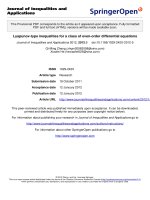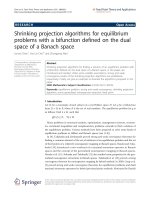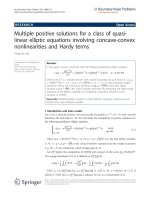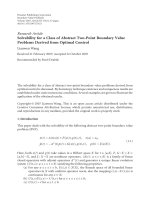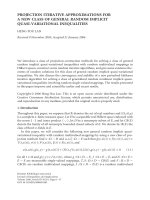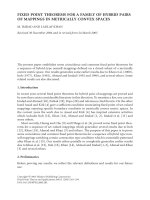Báo cáo toán học: "New upper bound for a class of vertex Folkman numbers" pptx
Bạn đang xem bản rút gọn của tài liệu. Xem và tải ngay bản đầy đủ của tài liệu tại đây (105.69 KB, 10 trang )
New upper bound for a class of vertex Folkman
numbers
N. Kolev
Department of Algebra
Faculty of Mathematics and Informatics
“St. Kl. Ohridski” University of Sofia
5 J. Bourchier blvd, 1164 Sofia
BULGARIA
N. Nenov
Department of Algebra
Faculty of Mathematics and Informatics
“St. Kl. Ohridski” University of Sofia
5 J. Bourchier blvd, 1164 Sofia
BULGARIA
Submitted: Jun 9, 2005; Accepted: Feb 7, 2006; Published: Feb 15, 2006
Mathematics Subject Classification: 05C55
Abstract
Let a
1
, ,a
r
be positive integers, m =
r
i=1
(a
i
−1)+1 and p =max{a
1
, ,a
r
}.
For a graph G the symbol G →{a
1
, ,a
r
} denotes that in every r-coloring of the
vertices of G there exists a monochromatic a
i
-clique of color i for some i =1, ,r.
The vertex Folkman numbers F (a
1
, ,a
r
; m − 1) = min{|V (G)| : G → (a
1
a
r
)
and K
m−1
⊆ G} are considered. We prove that F (a
1
, ,a
r
; m − 1) ≤ m +3p,
p ≥ 3. This inequality improves the bound for these numbers obtained by Luczak,
Ruci´nski and Urba´nski (2001).
1 Introduction
We consider only finite, non-oriented graphs without loops and multiple edges. We call a
p-clique of the graph G asetofp vertices, each two of which are adjacent. The largest
positive integer p, such that the graph G contains a p-clique is denoted by cl(G). In this
paper we shall also use the following notations:
V (G) - vertex set of the graph G;
E(G) - edge set of the graph G;
the electronic journal of combinatorics 13 (2006), #R14 1
¯
G - the complement of G;
G[V ], V ⊆ V (G) - the subgraph of G induced by V ;
G − V - the subgraph induced by the set V (G)\V ;
N
G
(v),v∈ V (G) - the set of all vertices of G adjacent to v;
K
n
- the complete graph on n vertices;
C
n
- simple cycle on n vertices;
P
n
-pathonn vertices;
χ(G) - the chromatic number of G;
x - the least positive integer greater or equal to x.
Let G
1
and G
2
be two graphs without common vertices. We denote by G
1
+ G
2
the
graph G for which V (G)=V (G
1
) ∪ V (G
2
)andE(G)=E(G
1
) ∪ E(G
2
) ∪ E
,where
E
= {[x, y] | x ∈ V (G
1
),y∈ V (G
2
)}.
Definition Let a
1
, ,a
r
be positive integers. We say that the r-coloring
V (G)=V
1
∪ ∪ V
r
,V
i
∩ V
j
= ∅,i= j,
of the vertices of the graph G is (a
1
, ,a
r
)-free, if V
i
does not contain an a
i
-clique for
each i ∈{1, ,r}. The symbol G → (a
1
, ,a
r
) means that there is no (a
1
, ,a
r
)-free
coloring of the vertices of G.
We consider for arbitrary natural numbers a
1
, ,a
r
and q
H(a
1
, a
r
; q)={G : G → (a
1
, ,a
r
)andcl(G) <q}.
The vertex Folkman numbers are defined by the equalities
F (a
1
, ,a
r
; q)=min{|V (G)| : G ∈ H(a
1
, ,a
r
; q)}.
It is clear that G → (a
1
, ,a
r
) implies cl(G) ≥ max{a
1
, ,a
r
}. Folkman [3] proved
that there exists a graph G such that G → (a
1
, ,a
r
)andcl(G)=max{a
1
, ,a
r
}.
Therefore
F (a
1
, ,a
r
; q) exists if and only if q>max{a
1
, ,a
r
}. (1)
These numbers are called vertex Folkman numbers. In [5] Luczak and Urba´nski defined
for arbitrary positive integers a
1
, ,a
r
the numbers
m = m(a
1
, ,a
r
)=
r
i=1
(a
i
− 1) + 1 and p = p(a
1
, ,a
r
)=max{a
1
, ,a
r
}. (2)
Obviously K
m
→ (a
1
, ,a
r
)andK
m−1
(a
1
, ,a
r
). Therefore if q ≥ m +1then
F (a
1
, ,a
r
; q)=m.
From (1) it follows that the number F (a
1
, ,a
r
; q) exists if and only if q ≥ p +1.
Luczak and Urba´nski [5] proved that F (a
1
, ,a
r
; m)=m + p. Later, in [6], Luczak,
Ruci´nski and Urba´nski proved that K
m−p−1
+
¯
C
2p+1
is the only graph in H(a
1
, ,a
r
; m)
with m + p vertices.
the electronic journal of combinatorics 13 (2006), #R14 2
From (1) it follows that the number F (a
1
, ,a
r
; m−1) exists if and only if m ≥ p+2.
An overview of the results about the numbers F (a
1
, ,a
r
; m − 1) was given in [1]. Here
we shall note only the general bounds for the numbers F (a
1
, ,a
r
; m − 1). In [8] the
following lower bound was proved
F (a
1
, ,a
r
; m − 1) ≥ m + p +2,p≥ 2.
In the above inequality an equality occurs in the case when max{a
1
, ,a
r
} =2and
m ≥ 5 (see [4],[6],[7]). For these reasons we shall further consider only the numbers
F (a
1
, ,a
r
; m − 1) when max{a
1
, ,a
r
}≥3.
In [6] Luczak, Ruci´nski and Urba´nski proved the following upper bound for the num-
bers F (a
1
, ,a
r
; m − 1):
F (a
1
, ,a
r
; m − 1) ≤ m + p
2
, for m ≥ 2p +2.
In [6] they also announced without proof the following inequality:
F (a
1
, ,a
r
; m − 1) ≤ 3p
2
+ p − mp +2m − 3, for p +3≤ m ≤ 2p +1.
In this paper we shall improve these bounds proving the following
Main theorem Let a
1
, ,a
r
be positive integers and m and p be defined by (2). Let
m ≥ p +2and p ≥ 3. Then
F (a
1
, ,a
r
; m − 1) ≤ m +3p.
Remark This bound is exact for the numbers F (2, 2, 3; 4) and F (3, 3; 4) because
F (2, 2, 3; 4) = 14 (see [2]) and F (3, 3; 4) = 14 (see [9]).
2 Main construction
We consider the cycle C
2p+1
. We assume that
V (C
2p+1
)={v
1
, ,v
2p+1
}
and
E(C
2p+1
)={[v
i
,v
i+1
],i=1, ,2p}∪{v
1
,v
2p+1
}.
Let σ denote the cyclic automorphism of C
2p+1
, i.e. σ(v
i
)=v
i+1
for i =1, ,2p,
σ(v
2p+1
)=v
1
. Using this automorphism and the set M
1
= V (C
2p+1
)\{v
1
,v
2p−1
,v
2p−2
} we
define M
i
= σ
i−1
(M
1
) for i =1, ,2p +1. Let Γ
p
denote the extension of the graph
¯
C
2p+1
obtained by adding the new pairwise independent vertices u
1
, ,u
2p+1
such that
N
Γ
p
(u
i
)=M
i
for i =1, ,2p +1. (3)
the electronic journal of combinatorics 13 (2006), #R14 3
We easily see that cl(
¯
C
2p+1
)=p.
Now we extend σ to an automorphism of Γ
p
via the equalities σ(u
i
)=u
i+1
, for
i =1, ,2p,andσ(u
2p+1
)=u
1
. Now it is clear that
σ is an automorphism of Γ
p
. (4)
The graph Γ
p
was defined for the first time in [8]. In [8] it is also proved that Γ
p
→ (3,p)
for p ≥ 3. For the proof of the main theorem we shall also use the following generalisation
of this fact.
Theorem 1 Let p ≥ 3 be a positive integer and m = p +2. Then for arbitrary positive
integers a
1
, ,a
r
(r is not fixed) such that
m =1+
r
i=1
(a
i
− 1)
and max{a
1
, ,a
r
}≤p we have
Γ
p
→ (a
1
, a
r
).
3 Auxiliary results
The next proposition is well known and easy to prove.
Proposition 1 Let a
1
, ,a
r
be positive integers and n = a
1
+ + a
r
. Then
a
1
2
+ +
a
r
2
≥
n
2
.
If n is even than this inequality is strict unless all the numbers a
1
, ,a
r
are even. If n
is odd then this inequality is strict unless exactly one of the numbers a
1
, ,a
r
is odd.
Let P
k
be the simple path on k vertices. Let us assume that
V (P
k
)={v
1
, ,v
k
}
and
E(P
k
)={[v
i
,v
i+1
],i=1, ,k− 1}.
We shall need the following obvious facts for the complementary graph
¯
P
k
of the
graph P
k
:
cl(
¯
P
k
)=
k
2
(5)
cl(
¯
P
2k
− v)=cl(
¯
P
2k
), for each v ∈ V (
¯
P
2k
)(6)
cl(
¯
P
2k
−{v
2k− 2
,v
2k− 1
})=cl(
¯
P
2k
) for k ≥ 2(7)
cl(
¯
P
2k+1
− v
2i
)=cl(
¯
P
2k+1
),i=1, ,k, k ≥ 1. (8)
The proof of Theorem 1 is based upon three lemmas.
the electronic journal of combinat orics 13 (2006), #R14 4
Lemma 1 Let V ⊂ V (C
2p+1
) and |V | = n<2p+1.LetG =
¯
C
2p+1
[V ] and let G
1
, ,G
s
be the connected components of the graph
¯
G = C
2p+1
[V ]. Then
cl(G) ≥
n
2
. (9)
If n is even, then (9) is strict unless all |V (G
i
)| for i =1, ,s are even. If n is odd,
then (9) is strict unless exactly one of the numbers |V (G
i
)| is odd.
Proof Let us observe that
G =
¯
G
1
+ +
¯
G
s
. (10)
Since V = V (C
2p+1
) each of the graphs G
i
is a path. From (10) and (5) it follows that
cl(G)=
s
i=1
n
i
2
,
where n
i
= |V (G
i
)|, i =1, ,s. From this inequality and Proposition 1 we obtain the
inequality (9). From Proposition 1 it also follows that if n is even then there is equality
in (9) if and only if the numbers n
1
, ,n
s
are even, and if n is odd then we have equality
in (9) if and only if exactly one of the numbers n
1
, ,n
s
is odd.
Corollary 1 It is true that cl(Γ
p
)=p.
Proof It is obvious that cl(
¯
C
2p+1
)=p and hence cl(Γ
p
) ≥ p. Let us denote an arbitrary
maximal clique of Γ
p
by Q. Let us assume that |Q| >p.ThenQ must contain a vertex u
i
for some i =1, ,2p + 1. As the vertices u
i
are pairwise independent Q must contain at
most one of them. Since σ is an automorphism of Γ
p
(see (4)) and u
i
= σ
i−1
(u
1
), we may
assume that Q contains u
1
. Let us assign the subgraph of Γ
p
induced by N
Γ
p
(u
1
)
= M
1
by
H. The connected components of H are {v
2
,v
3
, ,v
2p−3
} and {v
2p
,v
2p+1
} and both of
them contain an even number of vertices. Using Lemma 1 we have cl(H)=p − 1. Hence
|Q| = p and this contradicts the assumption.
The next two lemmas follow directly from (10), (6), (7), and (8) and need no proof.
Lemma 2 Let V V (C
2p+1
) and G =
¯
C
2p+1
[V ].LetP
k
= {v
1
,v
2
, ,v
k
} be a connected
component of the graph
¯
G = C
2p+1
[V ]. Then
(a) if k =2s then
cl(G − v
i
)=cl(G),i=1, ,2s,
and
cl(G −{v
2s−2
,v
2s−1
})=cl(G).
(b) if k =2s +1 then
cl(G − v
2i
)=cl(G),i=1, ,s.
the electronic journal of combinatorics 13 (2006), #R14 5
Lemma 3 Let V ⊆ V (C
2p+1
) and
¯
C
2p+1
= G.Let
P
2k
= {v
1
, ,v
2k
} and P
s
= {w
1
, ,w
s
}
be two connected components of the graph
¯
G = C
2p+1
[V ]. Then
(a) if s =2t then
cl(G −{v
i
,w
j
})=cl(G),
for i =1, ,2k, j =1, ,s, and
cl(G −{v
2k− 2
,v
2k− 1
,w
j
})=cl(G),
for j =1, ,s.
(b) If s =2t +1 then
cl(G −{v
2k− 2
,v
2k− 1
,w
2i
})=cl(G), for i =1, ,t.
4 Proof of Theorem 1
We shall prove Theorem 1 by induction on r.Asm =
r
i=1
(a
i
− 1) + 1 = p +2 and
max{a
1
, ,a
r
}≤p we have r ≥ 2. Therefore the base of the induction is r =2. We
warn the reader that the proof of the inductive base is much more involved then the proof
of the inductive step. Let r =2and(a
1
− 1) + (a
2
− 1) + 1 = p + 2 and max{a
1
,a
2
}≤p.
Then we have
a
1
+ a
2
= p +3. (11)
Since p ≥ 3andmax{a
1
,a
2
}≤p we have that
a
i
≥ 3,i=1, 2. (12)
We must prove that Γ
p
→ (a
1
,a
2
). Assume the opposite and let V (Γ
p
)=V
1
∪ V
2
be a
(a
1
,a
2
)-free coloring of V (Γ
p
). Define the sets
V
i
= V
i
∩ V (
¯
C
2p+1
),i=1, 2,
and the graphs
G
i
=
¯
C
2p+1
[V
i
],i=1, 2.
By assumption Γ
p
[V
i
] does not contain an a
i
-clique and hence Γ
p
[V
i
] does not contain an
a
i
-clique, too. Therefore from Lemma 1 we have |V
i
|≤2a
i
− 2, i =1, 2. From these
inequalities and the equality
|V
1
| + |V
2
| =2p +1=2a
1
+2a
2
− 5
(as p = a
1
+ a
2
− 3, see (11)) we have two possibilities:
|V
1
| =2a
1
− 2, |V
2
| =2a
2
− 3,
the electronic journal of combinatorics 13 (2006), #R14 6
or
|V
1
| =2a
1
− 3, |V
2
| =2a
2
− 2.
Without loss of generality we assume that
|V
1
| =2a
1
− 2, |V
2
| =2a
2
− 3. (13)
From (13) and Lemma 1 we obtain cl(G
i
) ≥ a
i
−1 and by the assumption that the coloring
V
1
∪ V
2
is (a
1
,a
2
)-free we have
cl(G
i
)=a
i
− 1 for i =1, 2. (14)
From (13), (14) and Lemma 1 we conclude that
The number of the vertices of each connected
component of
¯
G
1
is an even number;
(15)
and
the number of the vertices of exactly one of the
connected components of
¯
G
2
is an odd number.
(16)
According to (15) there are two possible cases.
Case 1. Some connected component of
¯
G
1
has more then two vertices. Now from (15)
it follows that this component has at least four vertices. Taking into consideration (15)
and (4) we may assume that {v
1
, ,v
2s
}, s ≥ 2, is a connected component of
¯
G
1
.Since
V
1
does not contain an a
1
-clique we have by Lemma 1 that s<a
1
. Therefore 2s +2≤ 2p
and we can consider the vertex u
2s+2
.
Subcase 1.a. Assume that u
2s+2
∈ V
1
.Letv
2s+2
∈ V
2
.Wehavefrom(3)that
N
Γ
p
(u
2s+2
) ⊇ V
1
−{v
2s−2
,v
2s−1
}. (17)
From (14) and Lemma 2(a) we have that the subgraph induced by V
1
−{v
2s−2
,v
2s−1
}
contains an (a
1
− 1)-clique Q. From (17) it follows that Q ∪{u
2s+2
} is an a
1
-clique in V
1
which is a contradiction.
Now let v
2s+2
∈ V
1
. From (3) we have
N
Γ
P
(u
2s+2
) ⊇ V
1
−{v
2s−2
,v
2s−1
,v
2s+2
}. (18)
According to (15) we can apply Lemma 3(a) for the connected component {v
1
, ,v
2s
}
of
¯
G
1
and the connected component of
¯
G
1
that contains v
2s+2
. We see from (14) and
Lemma 3(a) that V
1
−{v
2s−2
,v
2s−1
,v
2s+2
} contains an (a
1
− 1)-clique Q of the graph G
1
.
Now from (18) it follows that Q ∪{u
2s+2
} is an a
1
-clique in V
1
, which is a contradiction.
Subcase 1.b. Assume that u
2s+2
∈ V
2
.Ifv
2s+2
/∈ V
2
then from (3) it follows
N
Γ
p
(u
2s+2
) ⊇ V
2
. (19)
the electronic journal of combinatorics 13 (2006), #R14 7
As V
2
contains an (a
2
− 1)-clique Q (see (14)). From (19) it follows that Q ∪{u
2s+2
} is
an a
2
-clique in V
2
, which is a contradiction.
Now let v
2s+2
∈ V
2
. In this situation we have from (3)
N
Γ
p
(u
2s+2
) ⊇ V
2
−{v
2s+2
}. (20)
We shall prove that
V
2
−{v
2s+2
} contains an (a
2
− 1)-clique of Γ
p
. (21)
As v
2s
is the last vertex in the connected component of G
1
,wehavev
2s+1
∈ V
2
.LetL
be the connected component of
¯
G
2
containing v
2s+2
. Now we have L = {v
2s+1
,v
2s+2
, }.
Now (21) follows from Lemma 2 applied to the component L. From (20) and(21) it follows
that V
2
contains an a
2
-clique, which is a contradiction.
Case 2. Let all connected components of
¯
G
1
have exactly two vertices.
From (12) and (13) it follows that
¯
G
1
has at least two connected components. It is
clear that
¯
G
2
also has at least two components. From (16) we have that the number of
the vertices of at least one of the components of G
2
is even. From these considerations
and (4) it follows that it is enough to consider the situation when {v
1
,v
2
} is a connected
component of
¯
G
1
and {v
3
, ,v
2s
} is a component of
¯
G
2
,and{v
2s+1
,v
2s+2
} is a component
of
¯
G
1
. We shall consider two subcases.
Subcase 2.a. If u
2s+2
∈ V
1
.
Let s = 2. We apply Lemma 3(a) to the components {v
1
,v
2
} and {v
5
,v
6
}. From (14)
we conclude that
V
1
−{v
2
,v
6
} contains an (a
1
− 1)-clique. (22)
From (3) we have
N
Γ
p
(u
6
) ⊇ V
1
−{v
2
,v
6
}. (23)
Now (22) and (23) give that V
1
contains an a
1
-clique.
Let s ≥ 3. From (3) we have
N
Γ
p
(u
2s+2
) ⊇ V
1
−{v
2s+2
}. (24)
According to Lemma 2(a) V
1
−{v
2s+2
} contains an (a
1
−1)-clique. Now using (24) we have
that this (a
1
− 1)-clique together with the vertex u
2s+2
gives an a
1
-clique in V
1
. Subcase
2.a. is proved.
Subcase 2.b.Letu
2s+2
∈ V
2
.
Let s = 2. From (3) we have N
Γ
p
(u
6
) ⊇ V
2
−{v
3
}. According to Lemma 2(a) and
(14) V
2
−{v
3
} contains an (a
2
− 1)-clique. This clique together with u
2s+2
∈ V
2
gives an
a
2
-clique in V
2
, which is a contradiction.
Let s ≥ 3. Here from (3) we have N
Γ
p
(u
2s+2
) ⊇ V
2
−{v
2s−2
,v
2s−1
}. According to
Lemma 2(a) and (14) we have that V
2
−{v
2s−2
,v
2s−1
} contains an (a
2
− 1)-clique. This
the electronic journal of combinatorics 13 (2006), #R14 8
clique together with u
2s+2
∈ V
2
gives an a
2
-clique in V
2
, which is a contradiction. This
completes the proof of case 2 and of the inductive base r =2.
Now we more easily handle the case r ≥ 3. It is clear that
G → (a
1
, ,a
r
) ⇔ G → (a
ϕ(1)
, ,a
ϕ(r)
)
for any permutation ϕ ∈ S
r
. That is why we may assume that
a
1
≤ ≤ a
r
≤ p. (25)
We shall prove that a
1
+ a
2
− 1 ≤ p.Ifa
2
≤ 2thisistrivial:a
1
+ a
2
− 1 ≤ 3 ≤ p.Let
a
2
≥ 3. From (25) we have a
i
≥ 3, i =2, ,r. From these inequalities and the statement
of the theorem
r
i=1
(a
i
− 1) + 1 = p +2
we have
p +2≥ 1+(a
2
− 1) + (a
1
− 1) + 2(r − 2).
From this inequality and r ≥ 3 it follows that a
1
+ a
2
− 1 ≤ p.Thuswecannowusethe
inductive assumption and obtain
Γ
p
→ (a
1
+ a
2
− 1,a
3
, ,a
r
). (26)
Consider an arbitrary r-coloring V
1
∪ ∪ V
r
of V (Γ
p
). Let us assume that V
i
does not
contain an a
i
-clique for each i =3, ,r. Then from (26) we have V
1
∪ V
2
contains
(a
1
+ a
2
− 1)-clique. Now from the pigeonhole principle it follows that either V
1
contains
an a
1
-clique or V
2
contains an a
2
-clique. This completes the proof of Theorem 1.
5 Proof of the Main Theorem
Let m and p be positive integers p ≥ 3andm ≥ p + 2. We shall first prove that for
arbitrary positive integers a
1
, ,a
r
such that
m =1+
r
i=1
(a
i
− 1)
and max{a
1
, ,a
r
}≤p we have
K
m−p−2
+Γ
p
→ (a
1
, ,a
r
). (27)
We shall prove (27) by induction on t = m − p − 2. As m ≥ p +2thebaseist =0
and it follows from Theorem 1. Assume now t ≥ 1. Then obviously
K
m−p−2
+Γ
p
= K
1
+(K
m−p−3
+Γ
p
).
the electronic journal of combinatorics 13 (2006), #R14 9
Let V (K
1
)={w}. Consider an arbitrary r-coloring V
1
∪ ∪ V
r
of V (K
m−p−2
+Γ
p
). Let
w ∈ V
i
and V
j
, j = i, does not contain an a
j
-clique.
In order to prove (27) we need to prove that V
i
contains an a
i
-clique. If a
i
= 1 this is
clear as w ∈ V
i
.Leta
i
≥ 2. According to the inductive hypothesis we have
K
m−p−3
+Γ
p
→ (a
1
, ,a
i−1
,a
i
− 1,a
i+1
, ,a
r
). (28)
We consider the coloring
V
1
∪ ∪ V
i−1
∪{V
i
− w}∪ ∪ V
r
of V (K
m−p−3
+Γ
p
). As V
j
, j = i, do not contain a
j
-cliques, from (28) we have that
V
i
−{w} contains an (a
i
−1)-clique. This (a
i
−1)-clique together with w form an a
i
-clique
in V
i
. Thus (27) is proved.
From Corollary 1 obviously follows that cl(K
m−p−2
+Γ
p
)=m − 2. From this and (27)
we have K
m−p−2
+Γ
p
∈ H(a
1
, ,a
r
; m − 1). The number of the vertices of the graph
K
m−p−2
+Γ
p
is m +3p therefore F (a
1
, ,a
r
; m − 1) ≤ m +3p.
The main theorem is proved.
Acknowledgements. We are very grateful to the anonymous referee whose important
recommendations improved the presentation a lot.
References
[1] J. Coles, Algorithms for bounding Folkman numbers. Master thesis,
/>[2] J. Coles, S. Radziszowski, Computing the Folkman number F
v
(2, 2, 3; 4),
submitted.
[3] J. Folkman, Graphs with monochromatic complete subgraphs in every edge coloring,
SIAM. J. Appl. Math. 18, 1970, 19–24.
[4] P. Guta. On the structure of k-chromatic critical graphs of order k + p, Stud. Cern.
Math., 50, 1988, N 3–4, 169–173.
[5] T. Luczak, S. Urba´nski, A note on restricted vertex Ramsey numbers, Period. Math.
Hung., 33, 1996, 101–103.
[6] T. Luczak, A. Ruci´nski, S. Urba´nski, On minimal vertex Folkman graphs, Discrete
Math., 236, 2001, 245–262.
[7] N. Nenov, On the Zykov numbers and some its applications to Ramsey theory, Serdica
Bulgaricae math. publicationes 9, 1983, 161–167 (in Russian).
[8] N. Nenov, On a class of vertex Folkman graphs, Annuaire Univ. Sofia Fac. Math.
Inform. 94, 2000, 15–25.
[9] K. Piwakowski, S. Radziszowski, S. Urba´nski, Computation of the Folkman number
F
e
(3, 3; 5). J. Graph Theory 32, 1999, 41–49.
the electronic journal of combinatorics 13 (2006), #R14 10


